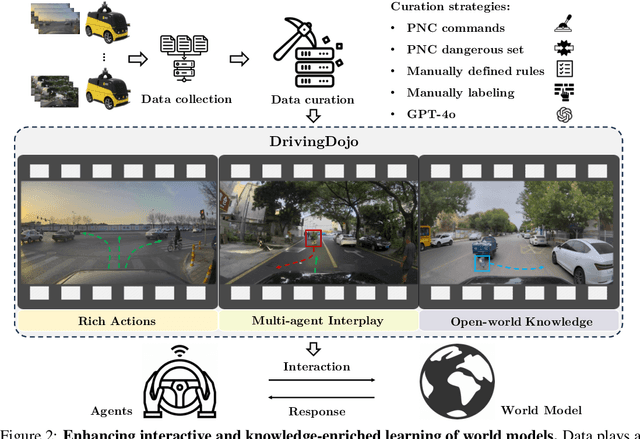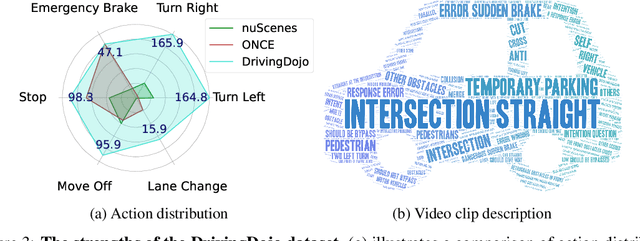Yuntao Chen
DriveVLA-W0: World Models Amplify Data Scaling Law in Autonomous Driving
Oct 14, 2025



Abstract:Scaling Vision-Language-Action (VLA) models on large-scale data offers a promising path to achieving a more generalized driving intelligence. However, VLA models are limited by a ``supervision deficit'': the vast model capacity is supervised by sparse, low-dimensional actions, leaving much of their representational power underutilized. To remedy this, we propose \textbf{DriveVLA-W0}, a training paradigm that employs world modeling to predict future images. This task generates a dense, self-supervised signal that compels the model to learn the underlying dynamics of the driving environment. We showcase the paradigm's versatility by instantiating it for two dominant VLA archetypes: an autoregressive world model for VLAs that use discrete visual tokens, and a diffusion world model for those operating on continuous visual features. Building on the rich representations learned from world modeling, we introduce a lightweight action expert to address the inference latency for real-time deployment. Extensive experiments on the NAVSIM v1/v2 benchmark and a 680x larger in-house dataset demonstrate that DriveVLA-W0 significantly outperforms BEV and VLA baselines. Crucially, it amplifies the data scaling law, showing that performance gains accelerate as the training dataset size increases.
Multi-Agent Tool-Integrated Policy Optimization
Oct 06, 2025



Abstract:Large language models (LLMs) increasingly rely on multi-turn tool-integrated planning for knowledge-intensive and complex reasoning tasks. Existing implementations typically rely on a single agent, but they suffer from limited context length and noisy tool responses. A natural solution is to adopt a multi-agent framework with planner- and worker-agents to manage context. However, no existing methods support effective reinforcement learning post-training of tool-integrated multi-agent frameworks. To address this gap, we propose Multi-Agent Tool-Integrated Policy Optimization (MATPO), which enables distinct roles (planner and worker) to be trained within a single LLM instance using role-specific prompts via reinforcement learning. MATPO is derived from a principled credit assignment mechanism across planner and worker rollouts. This design eliminates the need to deploy multiple LLMs, which would be memory-intensive, while preserving the benefits of specialization. Experiments on GAIA-text, WebWalkerQA, and FRAMES show that MATPO consistently outperforms single-agent baselines by an average of 18.38% relative improvement in performance and exhibits greater robustness to noisy tool outputs. Our findings highlight the effectiveness of unifying multiple agent roles within a single LLM and provide practical insights for stable and efficient multi-agent RL training.
Unified Vision-Language-Action Model
Jun 24, 2025



Abstract:Vision-language-action models (VLAs) have garnered significant attention for their potential in advancing robotic manipulation. However, previous approaches predominantly rely on the general comprehension capabilities of vision-language models (VLMs) to generate action signals, often overlooking the rich temporal and causal structure embedded in visual observations. In this paper, we present UniVLA, a unified and native multimodal VLA model that autoregressively models vision, language, and action signals as discrete token sequences. This formulation enables flexible multimodal tasks learning, particularly from large-scale video data. By incorporating world modeling during post-training, UniVLA captures causal dynamics from videos, facilitating effective transfer to downstream policy learning--especially for long-horizon tasks. Our approach sets new state-of-the-art results across several widely used simulation benchmarks, including CALVIN, LIBERO, and Simplenv-Bridge, significantly surpassing previous methods. For example, UniVLA achieves 95.5% average success rate on LIBERO benchmark, surpassing pi0-FAST's 85.5%. We further demonstrate its broad applicability on real-world ALOHA manipulation and autonomous driving.
Dita: Scaling Diffusion Transformer for Generalist Vision-Language-Action Policy
Mar 25, 2025Abstract:While recent vision-language-action models trained on diverse robot datasets exhibit promising generalization capabilities with limited in-domain data, their reliance on compact action heads to predict discretized or continuous actions constrains adaptability to heterogeneous action spaces. We present Dita, a scalable framework that leverages Transformer architectures to directly denoise continuous action sequences through a unified multimodal diffusion process. Departing from prior methods that condition denoising on fused embeddings via shallow networks, Dita employs in-context conditioning -- enabling fine-grained alignment between denoised actions and raw visual tokens from historical observations. This design explicitly models action deltas and environmental nuances. By scaling the diffusion action denoiser alongside the Transformer's scalability, Dita effectively integrates cross-embodiment datasets across diverse camera perspectives, observation scenes, tasks, and action spaces. Such synergy enhances robustness against various variances and facilitates the successful execution of long-horizon tasks. Evaluations across extensive benchmarks demonstrate state-of-the-art or comparative performance in simulation. Notably, Dita achieves robust real-world adaptation to environmental variances and complex long-horizon tasks through 10-shot finetuning, using only third-person camera inputs. The architecture establishes a versatile, lightweight and open-source baseline for generalist robot policy learning. Project Page: https://robodita.github.io.
AutoGUI: Scaling GUI Grounding with Automatic Functionality Annotations from LLMs
Feb 04, 2025



Abstract:User interface understanding with vision-language models has received much attention due to its potential for enabling next-generation software automation. However, existing UI datasets either only provide large-scale context-free element annotations or contextualized functional descriptions for elements at a much smaller scale. In this work, we propose the \methodname{} pipeline for automatically annotating UI elements with detailed functionality descriptions at scale. Specifically, we leverage large language models (LLMs) to infer element functionality by comparing the UI content changes before and after simulated interactions with specific UI elements. To improve annotation quality, we propose LLM-aided rejection and verification, eliminating invalid and incorrect annotations without human labor. We construct an \methodname{}-704k dataset using the proposed pipeline, featuring multi-resolution, multi-device screenshots, diverse data domains, and detailed functionality annotations that have never been provided by previous datasets. Human evaluation shows that the AutoGUI pipeline achieves annotation correctness comparable to trained human annotators. Extensive experimental results show that our \methodname{}-704k dataset remarkably enhances VLM's UI grounding capabilities, exhibits significant scaling effects, and outperforms existing web pre-training data types. We envision AutoGUI as a scalable pipeline for generating massive data to build GUI-oriented VLMs. AutoGUI dataset can be viewed at this anonymous URL: https://autogui-project.github.io/.
DrivingGPT: Unifying Driving World Modeling and Planning with Multi-modal Autoregressive Transformers
Dec 24, 2024



Abstract:World model-based searching and planning are widely recognized as a promising path toward human-level physical intelligence. However, current driving world models primarily rely on video diffusion models, which specialize in visual generation but lack the flexibility to incorporate other modalities like action. In contrast, autoregressive transformers have demonstrated exceptional capability in modeling multimodal data. Our work aims to unify both driving model simulation and trajectory planning into a single sequence modeling problem. We introduce a multimodal driving language based on interleaved image and action tokens, and develop DrivingGPT to learn joint world modeling and planning through standard next-token prediction. Our DrivingGPT demonstrates strong performance in both action-conditioned video generation and end-to-end planning, outperforming strong baselines on large-scale nuPlan and NAVSIM benchmarks.
OpenSatMap: A Fine-grained High-resolution Satellite Dataset for Large-scale Map Construction
Oct 30, 2024Abstract:In this paper, we propose OpenSatMap, a fine-grained, high-resolution satellite dataset for large-scale map construction. Map construction is one of the foundations of the transportation industry, such as navigation and autonomous driving. Extracting road structures from satellite images is an efficient way to construct large-scale maps. However, existing satellite datasets provide only coarse semantic-level labels with a relatively low resolution (up to level 19), impeding the advancement of this field. In contrast, the proposed OpenSatMap (1) has fine-grained instance-level annotations; (2) consists of high-resolution images (level 20); (3) is currently the largest one of its kind; (4) collects data with high diversity. Moreover, OpenSatMap covers and aligns with the popular nuScenes dataset and Argoverse 2 dataset to potentially advance autonomous driving technologies. By publishing and maintaining the dataset, we provide a high-quality benchmark for satellite-based map construction and downstream tasks like autonomous driving.
FreeVS: Generative View Synthesis on Free Driving Trajectory
Oct 23, 2024



Abstract:Existing reconstruction-based novel view synthesis methods for driving scenes focus on synthesizing camera views along the recorded trajectory of the ego vehicle. Their image rendering performance will severely degrade on viewpoints falling out of the recorded trajectory, where camera rays are untrained. We propose FreeVS, a novel fully generative approach that can synthesize camera views on free new trajectories in real driving scenes. To control the generation results to be 3D consistent with the real scenes and accurate in viewpoint pose, we propose the pseudo-image representation of view priors to control the generation process. Viewpoint transformation simulation is applied on pseudo-images to simulate camera movement in each direction. Once trained, FreeVS can be applied to any validation sequences without reconstruction process and synthesis views on novel trajectories. Moreover, we propose two new challenging benchmarks tailored to driving scenes, which are novel camera synthesis and novel trajectory synthesis, emphasizing the freedom of viewpoints. Given that no ground truth images are available on novel trajectories, we also propose to evaluate the consistency of images synthesized on novel trajectories with 3D perception models. Experiments on the Waymo Open Dataset show that FreeVS has a strong image synthesis performance on both the recorded trajectories and novel trajectories. Project Page: https://freevs24.github.io/
Diffusion Transformer Policy
Oct 21, 2024



Abstract:Recent large visual-language action models pretrained on diverse robot datasets have demonstrated the potential for generalizing to new environments with a few in-domain data. However, those approaches usually predict discretized or continuous actions by a small action head, which limits the ability in handling diverse action spaces. In contrast, we model the continuous action with a large multi-modal diffusion transformer, dubbed as Diffusion Transformer Policy, in which we directly denoise action chunks by a large transformer model rather than a small action head. By leveraging the scaling capability of transformers, the proposed approach can effectively model continuous end-effector actions across large diverse robot datasets, and achieve better generalization performance. Extensive experiments demonstrate Diffusion Transformer Policy pretrained on diverse robot data can generalize to different embodiments, including simulation environments like Maniskill2 and Calvin, as well as the real-world Franka arm. Specifically, without bells and whistles, the proposed approach achieves state-of-the-art performance with only a single third-view camera stream in the Calvin novel task setting (ABC->D), improving the average number of tasks completed in a row of 5 to 3.6, and the pretraining stage significantly facilitates the success sequence length on the Calvin by over 1.2. The code will be publicly available.
DrivingDojo Dataset: Advancing Interactive and Knowledge-Enriched Driving World Model
Oct 14, 2024



Abstract:Driving world models have gained increasing attention due to their ability to model complex physical dynamics. However, their superb modeling capability is yet to be fully unleashed due to the limited video diversity in current driving datasets. We introduce DrivingDojo, the first dataset tailor-made for training interactive world models with complex driving dynamics. Our dataset features video clips with a complete set of driving maneuvers, diverse multi-agent interplay, and rich open-world driving knowledge, laying a stepping stone for future world model development. We further define an action instruction following (AIF) benchmark for world models and demonstrate the superiority of the proposed dataset for generating action-controlled future predictions.
 Add to Chrome
Add to Chrome Add to Firefox
Add to Firefox Add to Edge
Add to Edge